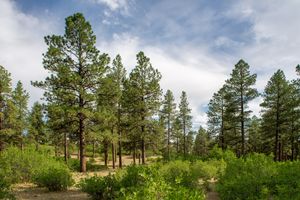ponderosa pine
- Also called:
- western yellow pine or bull pine
- Related Topics:
- pine
Where is the ponderosa pine found?
How does the ponderosa pine benefit wildlife?
What are some uses of the ponderosa pine by Indigenous peoples?
What is the significance of the ponderosa pine in the lumber industry?
ponderosa pine, (Pinus ponderosa), species of large, North Americapine tree noted for its soft, easily worked wood. It is the most widely distributed American pine, found in the mountain forests of western North America from British Columbia to North Dakota and south to Texas and Mexico.
Physical description
The ponderosa pine can grow 45 to 60 meters (148 to 197 feet) high, with a trunk 1.5 to 2.5 meters (5 to 8 feet) in diameter. Its needles, which can measure up to 25 cm (10 inches) long, are clustered into groups of three. The thick bark begins as brown or black, but turns lighter as it ages, eventually turning to an orange or cinnamon shade. The bark is fragrant—smelling like vanilla or butterscotch—and helps protect the living tissues within from wildfires and lightning strikes. The tree’s widespread roots, which can penetrate 46 meters (150 feet) into the soil, allow it to access deep and moist layers of soil and provide stability in windy conditions. As a gymnosperm, the tree bears its seeds in prickly cones, which grow in a two-year cycle and often reach 15 cm (6 inches) in length. Some trees can live to about 600 years.
(Read Britannica’s “The 7 Best Pinecones [Really!]”)
Importance
A major component of forest ecosystems throughout its range, the tree provides food and shelter for numerous animals. The seeds are an important food source for wild turkeys, grouse, squirrels, chipmunks, and mice, many of which also nest in the tree. The plant supports countless insects, spiders, and other arthropods, including white pine cone beetles and pine budworms, and is a host of the pine white butterfly (Neophasia menapia), whose caterpillars feed on the tree. The tree also hosts parasitic dwarf mistletoe (genus Arceuthobium).
The ponderosa pine is the state tree of Montana.
The ponderosa pine has a long history of use by numerous Indigenous peoples and is a source of food, fiber, medicines, and wood for ceremonial objects. Medicinally, it can be used as an antiseptic and is believed to treat respiratory problems. The seeds can be ground into flour, and the inner bark, which is rich in protein, can be eaten.
One of the most important lumber trees in the western United States, its soft, light-colored wood is nonporous and straight-grained. Extremely versatile, it is used in both interior and exterior woodworking projects, such as subflooring, window frames, and furniture.
















